As collectors, we
like to identify and categorise our collections, to bring order out of
chaos and tie up loose ends. Where we have unidentified models,
the urge to classify things makes us look for similarities with known
models and draw inferences about the origins of the unknown items which
may sometimes be based on the flimsiest of evidence.
The
late 1940s has more than its fair share of toys by small or
unidentified manufacturers to be classified and categorised. This
is not so surprising, because metal toys had been virtually
unobtainable from 1942-45, and metal was still in short supply.
Quality toys, such as Dinky and Britains were needed for the export
drive, so that in the home market almost any metal blob with four
wheels could be sold as a toy car. Many small engineering firms
tried their hand at making die-cast toys. Some companies grew
into household name toy firms (e.g. Lesney, Lone Star) while others
faded away, returning to industrial die-casting or disappearing
altogether. A watershed in this process came in 1951-2, when
there was a ban on using zinc in toy manufacture, as a consequence of
the Korean war. This hit die-cast toy makers quite heavily, and
many minor firms did not reappear after the ban was lifted.
The
models in this article are all from the 1946-51 period, and are those
that I have been able to group together by some similarities and common
features as 'South London - late 1940s', as opposed to the much larger
number of models from small firms in North London, or indeed the West
Midlands/Stoke-on-Trent toys which have their own characteristics.
Our
starting point is a firm called Arbur Products Ltd., which was
incorporated in late 1946. Unfortunately, Companies House records
get us no further than this because the file has been destroyed.
The company was listed in the London street directory, in 1948 only, as
toy makers, of 44 Molesworth Street, Lewisham, London S.E.13. After this article appeared online, I
was contacted by the daughter of one of the partners in the firm, and
she gave me a little more history. The partners were Les Arlow
and Ernie Burridge, and the combination of their surnames gave the name
'Arbur'. They were both bus drivers in south London before
starting toy production. Their premises at the rear of 44
Molesworth Street were rented from Ernie's future mother-in-law.
Ernie employed her eldest daughter in the office, and later married her!
Arbur made some lead soldiers, but as
far I know they were unmarked. There
are several die-cast
models marked with the Arbur name, all but one of which had
turned brass wheel hubs with smooth black rubber tyres. The
wheels can look as good as new if you shine them up with some metal
polish! These brass hubs were a bought-in component, and can also
be found on models by Timpo, Betal and Kemlows.
Ernie and Les had a falling-out
which resulted in the
company closing around 1947 or 1948, and Ernie returned to driving as a
coach driver. Some
of the Arbur dies seem to have passed to other manufacturers
(presumably after 1948) and on various models we can find the names
LDCW, DHE Co. Products, and Rollee Products. More details of
these are given under the individual model descriptions, but I have
been unable to find any of these names in street directories or other
contemporary sources.
I
propose first to describe the models which are marked Arbur, and then
the 'others' which appear to have some connection to this little group.
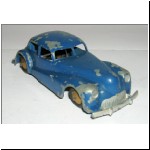 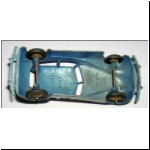 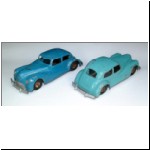 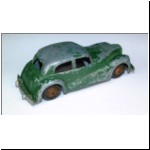 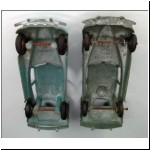 Buick Sedan
Length
107mm
The
front end of the model, with its radiator grille and large badge above,
is recognisably based on the 1946-8 Buick, although the rear end of the
car is more British in style. I have seen original examples in red, black, light blue, medium blue,
dark
blue or
green
paint. MADE IN ENGLAND was cast under the bonnet and ARBUR
PRODUCTS under the roof. There are many
detailed differences
between the blue and green
models shown, due to
modifications to the die.
The earlier models (the blue examples) had open space between the
bumpers
and bodywork, later filled in (on the green example). The earlier
cylindrical axle supports were replaced by much thinner supports; two
casting ejectors were added to the later model, resulting in the MADE
IN ENGLAND lettering being moved further to the rear; and the quotation
marks around "ARBUR" on the earlier models disappeared on the later
version. There is also an
interim version with the bumper openings filled in but still with the
cylindrical axle supports (not illustrated). The axles were
fitted to the cylindrical supports either through drilled holes (as in
the fifth photo above) or by inserting the axles into slots in the
supports, with the two sides then squeezed together (as in the second
photo). Thanks to Kerry Hamer for pointing out this variation.
Buick Sedan
Length
107mm
The
front end of the model, with its radiator grille and large badge above,
is recognisably based on the 1946-8 Buick, although the rear end of the
car is more British in style. I have seen original examples in red, black, light blue, medium blue,
dark
blue or
green
paint. MADE IN ENGLAND was cast under the bonnet and ARBUR
PRODUCTS under the roof. There are many
detailed differences
between the blue and green
models shown, due to
modifications to the die.
The earlier models (the blue examples) had open space between the
bumpers
and bodywork, later filled in (on the green example). The earlier
cylindrical axle supports were replaced by much thinner supports; two
casting ejectors were added to the later model, resulting in the MADE
IN ENGLAND lettering being moved further to the rear; and the quotation
marks around "ARBUR" on the earlier models disappeared on the later
version. There is also an
interim version with the bumper openings filled in but still with the
cylindrical axle supports (not illustrated). The axles were
fitted to the cylindrical supports either through drilled holes (as in
the fifth photo above) or by inserting the axles into slots in the
supports, with the two sides then squeezed together (as in the second
photo). Thanks to Kerry Hamer for pointing out this variation.
 Streamlined Fire
Engine - 4 windows, 2 bells
Length
104mm
Loosely
based on the Dinky Toy (25h), there are two versions of the Arbur fire
engine which seem to be from different dies. The first version
had two windows on each side and two bells cast on the roof.
ARBUR PRODUCTS MADE IN ENGLAND was cast underneath the roof.
Paint was red, of course, and there was a separate unpainted ladder. Streamlined Fire
Engine - 4 windows, 2 bells
Length
104mm
Loosely
based on the Dinky Toy (25h), there are two versions of the Arbur fire
engine which seem to be from different dies. The first version
had two windows on each side and two bells cast on the roof.
ARBUR PRODUCTS MADE IN ENGLAND was cast underneath the roof.
Paint was red, of course, and there was a separate unpainted ladder.
  Streamlined Fire
Engine - 6 windows, 1 bell
Length
104mm
This
fire engine has so many differences from the four-window version that
it must be from a new die. The most obvious difference is that
there were three windows on each side rather than two, but only one
bell on the roof. MADE IN ENGLAND was cast under the bonnet and
ARBUR PRODUCTS under the roof. The ten-rung ladder (length 101mm)
shown in the photo with this model is thought to be original, whereas
the other ladders shown are probably not. This
die was later modified to delete the ARBUR PRODUCTS name, and replace
it with the letters LDCW. At the same time some new casting
ejectors were added, and the axle supports were modified. The
LDCW letters look like typewriter script, and were presumably done with
some kind of stamp in the die. The letter C could actually be a
G, because it has a tail, but I tend to think it was intended to be a
C, because then the letters might stand for 'L------- Die Casting
Works'. Maybe the L was for Lewisham? Or London? I
have not found any names in directories that might fit. The LDCW
fire engine retained the unpainted ladder and brass wheel hubs of the
Arbur. Streamlined Fire
Engine - 6 windows, 1 bell
Length
104mm
This
fire engine has so many differences from the four-window version that
it must be from a new die. The most obvious difference is that
there were three windows on each side rather than two, but only one
bell on the roof. MADE IN ENGLAND was cast under the bonnet and
ARBUR PRODUCTS under the roof. The ten-rung ladder (length 101mm)
shown in the photo with this model is thought to be original, whereas
the other ladders shown are probably not. This
die was later modified to delete the ARBUR PRODUCTS name, and replace
it with the letters LDCW. At the same time some new casting
ejectors were added, and the axle supports were modified. The
LDCW letters look like typewriter script, and were presumably done with
some kind of stamp in the die. The letter C could actually be a
G, because it has a tail, but I tend to think it was intended to be a
C, because then the letters might stand for 'L------- Die Casting
Works'. Maybe the L was for Lewisham? Or London? I
have not found any names in directories that might fit. The LDCW
fire engine retained the unpainted ladder and brass wheel hubs of the
Arbur.
 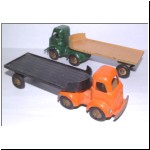  Forward Control
Articulated Flat Lorry
Length
132mm
At
first sight this crude model is not based on any particular prototype,
but in fact the tractor unit is remarkably similar to some cast iron
toys by the American maker Hubley from the 1930s. The photograph
reproduced here from Modellers' World
(vol.5 no.2, January 1976) shows
two Hubley car transporters, and according to Clint Seeley ('CBC Lee')
who wrote the article in which the illustration appears, the Hubleys
were models of a cab-over design by International. American cast
iron toys are rare in Europe, because by and large they were not
exported, but somehow it seems that Arbur had found a 1930s Hubley to
copy. MADE
IN ENGLAND ARBUR PRODUCTS was cast under the front end of the trailer,
but there was no identification on the cab. Three colour variations are pictured
here - black/orange, orange/black and dark green/beige. I have also seen a red cab with dark
green trailer, and no doubt other colours
exist. Forward Control
Articulated Flat Lorry
Length
132mm
At
first sight this crude model is not based on any particular prototype,
but in fact the tractor unit is remarkably similar to some cast iron
toys by the American maker Hubley from the 1930s. The photograph
reproduced here from Modellers' World
(vol.5 no.2, January 1976) shows
two Hubley car transporters, and according to Clint Seeley ('CBC Lee')
who wrote the article in which the illustration appears, the Hubleys
were models of a cab-over design by International. American cast
iron toys are rare in Europe, because by and large they were not
exported, but somehow it seems that Arbur had found a 1930s Hubley to
copy. MADE
IN ENGLAND ARBUR PRODUCTS was cast under the front end of the trailer,
but there was no identification on the cab. Three colour variations are pictured
here - black/orange, orange/black and dark green/beige. I have also seen a red cab with dark
green trailer, and no doubt other colours
exist.
  Forward Control
Articulated Box Van
Length
125mm
The
forward control cab unit was also married to a box trailer which is
reminiscent of the Timpo toy. The red and brown cabs shown here
are a
slightly later casting than on the flat lorries, having all the space
between the bumper and front mudguards filled in. The
turquoise trailer has no sign of any adverts and no identification
cast on it. A casting ejector circle forms a sort of step at the
rear end of the model. Forward Control
Articulated Box Van
Length
125mm
The
forward control cab unit was also married to a box trailer which is
reminiscent of the Timpo toy. The red and brown cabs shown here
are a
slightly later casting than on the flat lorries, having all the space
between the bumper and front mudguards filled in. The
turquoise trailer has no sign of any adverts and no identification
cast on it. A casting ejector circle forms a sort of step at the
rear end of the model.
 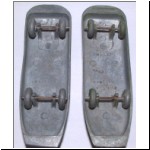 Gardner's MG Magnette
Record Car
Length
103mm
This
was a good copy of Dinky Toys 23p. Unlike the Dinky there was no
baseplate, and the concealed wheels were solid unpainted metal, without
tyres; this was the only Arbur model without brass hubs. An
octagonal MG badge was cast at the front, where the Dinky Toy had a
transfer. The first version had ARBUR PRODUCTS MADE IN ENGLAND
cast underneath. Presumably the die then changed hands because
the ARBUR name was removed and replaced by DHE.Co. The words
PRODUCTS and MADE IN ENGLAND remained. The letters of DHE.Co were
in 'typewriter' script, like LDCW, and again the C had a tail, making
it look a bit like a G. This tends to confirm that the letter was
really intended to be a C, since 'Co' is more meaningful than
'Go'! I would speculate that these initials stood for 'D-------
H------- Engineering Co.', but have been unable to identify this
company, or work out the connection, which the style of lettering
implies existed, with LDCW. To
complicate things further, there was then a third version of the MG
record car with DHE.Co removed and replaced by the name ROLLEE in
conventional lettering. The words PRODUCTS and MADE IN ENGLAND
still remained. Again this is a complete enigma, and neither
DHE.Co nor ROLLEE have been found on any other toys. Also there
is no doubt about the order in which the die was modified because
traces of the DHE.Co name can be seen on the ROLLEE version.
The
metallic blue colour of the DHE.Co model illustrated is original.
I cannot be certain of any other original colours, although red has
been listed (see Model Auto Review,
no.48, December 1990). Gardner's MG Magnette
Record Car
Length
103mm
This
was a good copy of Dinky Toys 23p. Unlike the Dinky there was no
baseplate, and the concealed wheels were solid unpainted metal, without
tyres; this was the only Arbur model without brass hubs. An
octagonal MG badge was cast at the front, where the Dinky Toy had a
transfer. The first version had ARBUR PRODUCTS MADE IN ENGLAND
cast underneath. Presumably the die then changed hands because
the ARBUR name was removed and replaced by DHE.Co. The words
PRODUCTS and MADE IN ENGLAND remained. The letters of DHE.Co were
in 'typewriter' script, like LDCW, and again the C had a tail, making
it look a bit like a G. This tends to confirm that the letter was
really intended to be a C, since 'Co' is more meaningful than
'Go'! I would speculate that these initials stood for 'D-------
H------- Engineering Co.', but have been unable to identify this
company, or work out the connection, which the style of lettering
implies existed, with LDCW. To
complicate things further, there was then a third version of the MG
record car with DHE.Co removed and replaced by the name ROLLEE in
conventional lettering. The words PRODUCTS and MADE IN ENGLAND
still remained. Again this is a complete enigma, and neither
DHE.Co nor ROLLEE have been found on any other toys. Also there
is no doubt about the order in which the die was modified because
traces of the DHE.Co name can be seen on the ROLLEE version.
The
metallic blue colour of the DHE.Co model illustrated is original.
I cannot be certain of any other original colours, although red has
been listed (see Model Auto Review,
no.48, December 1990).
  Normal
Control
Articulated Open Wagon
Length
141mm
This
and the fire engine are the only known models marked LDCW. There
are many similarities to the Arbur flat lorry, suggesting that the
designer or toolmaker was the same. The cab unit looks like the
Arbur with a bonnet stuck on the front. MADE IN UK was cast under
the rear platform, while the lowside trailer had LDCW cast
underneath. Brass wheel hubs with black tyres were fitted. Colours
included red cab/grey trailer,
purple cab/dark green trailer,
pinkish-red cab and trailer, or blue cab and trailer. Normal
Control
Articulated Open Wagon
Length
141mm
This
and the fire engine are the only known models marked LDCW. There
are many similarities to the Arbur flat lorry, suggesting that the
designer or toolmaker was the same. The cab unit looks like the
Arbur with a bonnet stuck on the front. MADE IN UK was cast under
the rear platform, while the lowside trailer had LDCW cast
underneath. Brass wheel hubs with black tyres were fitted. Colours
included red cab/grey trailer,
purple cab/dark green trailer,
pinkish-red cab and trailer, or blue cab and trailer.
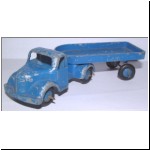  Bedford Articulated
Open Wagon
Length
144mm
The
same toolmaker was at work again on this model. The cab was a
more conventional looking normal control type, the radiator grille
making it closer to a Bedford than anything else, although it should
have had a divided windscreen. The lowside trailer was wider and
shorter than the LDCW. The brass wheel hubs always seem to have
been fitted before painting, so that they are sprayed on the outside
face. No
identification was cast anywhere on the model,
although the two examples illustrated both have the original price of
2/6 pencilled under the trailer! Colours: green or red. Also found in blue. This one
also has the price of 2/6 pencilled under the
trailer! Bedford Articulated
Open Wagon
Length
144mm
The
same toolmaker was at work again on this model. The cab was a
more conventional looking normal control type, the radiator grille
making it closer to a Bedford than anything else, although it should
have had a divided windscreen. The lowside trailer was wider and
shorter than the LDCW. The brass wheel hubs always seem to have
been fitted before painting, so that they are sprayed on the outside
face. No
identification was cast anywhere on the model,
although the two examples illustrated both have the original price of
2/6 pencilled under the trailer! Colours: green or red. Also found in blue. This one
also has the price of 2/6 pencilled under the
trailer!
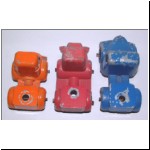 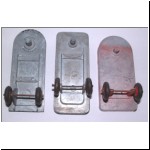
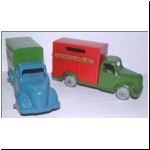 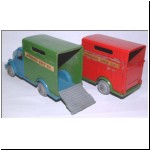 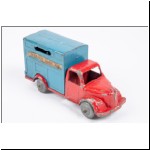 Newmarket Horse Box
Length
119mm
Compare
the front view of this model with the Bedford articulated wagon and it
is obvious that the same toolmaker made this die as well. There
is no connection other than design between this model and the previous
items, but the grille, headlights and bonnet convince me that the same
hand was at work. Of course it may be the case that the models
were cast by different companies, but they went to the same man to make
their dies. We may never know, but there is always the
possibility that an original box or another variation of the model will
turn up, which may add a little extra piece of information. Newmarket Horse Box
Length
119mm
Compare
the front view of this model with the Bedford articulated wagon and it
is obvious that the same toolmaker made this die as well. There
is no connection other than design between this model and the previous
items, but the grille, headlights and bonnet convince me that the same
hand was at work. Of course it may be the case that the models
were cast by different companies, but they went to the same man to make
their dies. We may never know, but there is always the
possibility that an original box or another variation of the model will
turn up, which may add a little extra piece of information.
 Update: Amazingly, after
writing the above, an original box has turned up, and it was a surprise to
find that the horse box was made by a familiar company - Cleveland Toy
Manufacturing Co. of 102 Cleveland Street, London, W1, whose brand name
was 'Teeny Toy'. This firm merits a page in its own right, but
meanwhile I will leave the model here! Update: Amazingly, after
writing the above, an original box has turned up, and it was a surprise to
find that the horse box was made by a familiar company - Cleveland Toy
Manufacturing Co. of 102 Cleveland Street, London, W1, whose brand name
was 'Teeny Toy'. This firm merits a page in its own right, but
meanwhile I will leave the model here!
The
horse box body was a separate casting riveted to the cab/chassis, and
there was also a separate let-down tailboard. No lettering was
cast on the model, but paper labels reading NEWMARKET HORSE BOX in
sepia coloured print were applied to each side. Wheels were solid
unpainted metal castings. I have never seen a die-cast horse that
might be suitable for this model - probably there are enough lead
farmyard horses around that the makers did not bother to provide
one. The model has been
found in the following colour combinations (cab and chassis colour
first, then body and tailboard): green/blue, blue/green,
green/red, red/green and
red/blue.
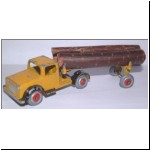 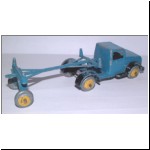  Bedford Articulated
Log Transporter
Length
155mm
The
tractor unit is a reasonable likeness of the wartime Bedford. The
bonnet is a little too long and it should have a divided screen, but
nonetheless this would have been a recognisable model to a boy in the
late 1940s. The trailer looks a little fragile, and it is true
that the tractor unit turns up on its own more often than the complete
model. Wheels
were the same as on the Newmarket horse box, apart from a casting
variation on the inner face. A different type of solid metal
wheel, rather flatter in section, can also be found on this
model, as pictured on the green
example here. No identification was cast anywhere, but the wheels make it likely this is
another Teeny Toy. The
colour schemes always included silver headlights and grille,
black mudguards, and the wheel hubs painted a contrasting colour.
I have seen yellow with red hubs, red with yellow hubs, blue with
yellow hubs, and green with
yellow hubs. The yellow model illustrated here has three
twigs as
a 'log' load. I have no idea if these are original, but they look
quite effective! Bedford Articulated
Log Transporter
Length
155mm
The
tractor unit is a reasonable likeness of the wartime Bedford. The
bonnet is a little too long and it should have a divided screen, but
nonetheless this would have been a recognisable model to a boy in the
late 1940s. The trailer looks a little fragile, and it is true
that the tractor unit turns up on its own more often than the complete
model. Wheels
were the same as on the Newmarket horse box, apart from a casting
variation on the inner face. A different type of solid metal
wheel, rather flatter in section, can also be found on this
model, as pictured on the green
example here. No identification was cast anywhere, but the wheels make it likely this is
another Teeny Toy. The
colour schemes always included silver headlights and grille,
black mudguards, and the wheel hubs painted a contrasting colour.
I have seen yellow with red hubs, red with yellow hubs, blue with
yellow hubs, and green with
yellow hubs. The yellow model illustrated here has three
twigs as
a 'log' load. I have no idea if these are original, but they look
quite effective!
 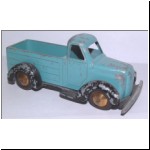 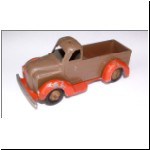 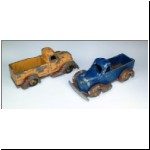  Timpo
Pick-Up
Length
97mm
I
have included this model in the article because the brass hubs and
crude appearance mean that it is often attributed to Arbur.
However, it started life as a Timpo toy. The first version
probably dates from 1945,
and had TIMPO TOYS (in script) and
MADE IN ENGLAND (in capitals) cast underneath, together with normal
Timpo die-cast wheels and rubber tyres. Probably the model was dropped by
Timpo because it was more expensive to produce than their simpler
one-piece diecast vehicles, and the sub-contract manufacturer then
continued to produce the toy and sell it through other channels.
The TIMPO TOYS name was blanked out,
leaving just MADE IN ENGLAND cast on the base, and this version always
had brass hubs. There is really no other evidence
for Arbur as the manufacturer, and as has already been mentioned,
identical brass hubs were used by others, including Timpo
themselves. Colours included blue body/red chassis, dark green
body/red chassis, light blue body/black chassis, yellow-ochre
body/maroon chassis, brown
body/orange chassis, dark blue body/brown chassis and orange body/green
chassis..
Rarity
I
think it is fair to say that most of the models described in this
article are hard to find. The exceptions are the articulated flat
lorry and the six-window fire engine, which are relatively common, and
the LDCW articulated truck also turns up reasonably often. Rarity
of course is not always matched by high prices, but there are now quite
a lot of collectors who are interested in these obscure toys.
They have the simplicity and charm of items made purely as toys, and
present a real collecting challenge - but don't insist on mint and
boxed condition, because you won't find very much if you do!
Acknowledgements:
Thanks to Lesley Chapman, Ron Blair and Colin Penn for their
contributions.
Timpo
Pick-Up
Length
97mm
I
have included this model in the article because the brass hubs and
crude appearance mean that it is often attributed to Arbur.
However, it started life as a Timpo toy. The first version
probably dates from 1945,
and had TIMPO TOYS (in script) and
MADE IN ENGLAND (in capitals) cast underneath, together with normal
Timpo die-cast wheels and rubber tyres. Probably the model was dropped by
Timpo because it was more expensive to produce than their simpler
one-piece diecast vehicles, and the sub-contract manufacturer then
continued to produce the toy and sell it through other channels.
The TIMPO TOYS name was blanked out,
leaving just MADE IN ENGLAND cast on the base, and this version always
had brass hubs. There is really no other evidence
for Arbur as the manufacturer, and as has already been mentioned,
identical brass hubs were used by others, including Timpo
themselves. Colours included blue body/red chassis, dark green
body/red chassis, light blue body/black chassis, yellow-ochre
body/maroon chassis, brown
body/orange chassis, dark blue body/brown chassis and orange body/green
chassis..
Rarity
I
think it is fair to say that most of the models described in this
article are hard to find. The exceptions are the articulated flat
lorry and the six-window fire engine, which are relatively common, and
the LDCW articulated truck also turns up reasonably often. Rarity
of course is not always matched by high prices, but there are now quite
a lot of collectors who are interested in these obscure toys.
They have the simplicity and charm of items made purely as toys, and
present a real collecting challenge - but don't insist on mint and
boxed condition, because you won't find very much if you do!
Acknowledgements:
Thanks to Lesley Chapman, Ron Blair and Colin Penn for their
contributions.
|
































